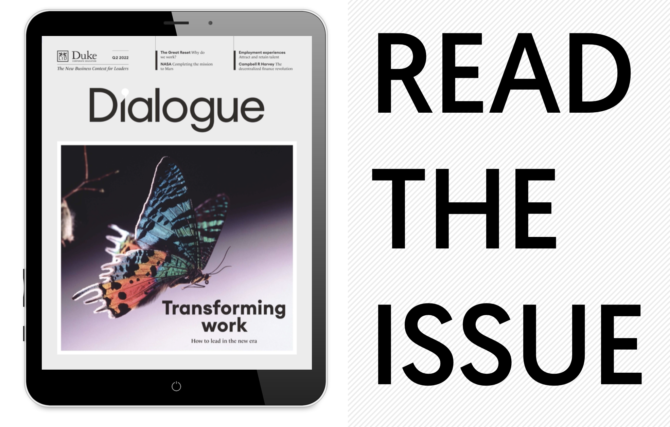Discussions about the future of business can feel very distant: something that’s ‘over there’, being shaped by brilliant-but-remote tech visionaries, done to us rather than by us. That can feel disempowering: we know our lives will be shaped for years to come by the decisions that other people are taking, but we have little knowledge of what they’re thinking and even less scope for influencing them. How many of us have input on the algorithms that will make life-and-death decisions in the trajectory of driverless vehicles, say? On the innovations that could revolutionize medicine and healthcare? Or those that are redefining the boundaries of warfare?
Yet when it comes to shaping the future of work itself, the opposite is the case. We are all participants in creating the future, and those in leadership roles have more influence than most. We hold the future in our hands. As Peter Drucker once said: “The best way to predict your future is to create it.”
Indeed, the last two years have felt like a particularly intensive period of future-creating. Since the pandemic hit, we have been prompted to rethink every aspect of how we work. As Heather E McGowan and Chris Shipley write: who works, what we do at work, where we work and how we measure work are all in flux – as is the fundamental question of why we work.
The Great Resignation is a sign that individual workers are ahead of organizations in seizing the opportunity to create their future. How can businesses catch up? In the first place, by thinking again about the employment experience, argue B Joseph Pine II and James H Gilmore. One of the most immediate jobs at hand is adapting to hybrid working: Alexia Cambon of Gartner sets out principles for designing effective hybrid work systems. For the longer term, understanding the powerful drivers of change that are in play is also essential: Jacob Morgan identifies the six trends shaping the future for leaders everywhere.
Ryan Jenkins, meanwhile, highlights the need for leaders to build stronger personal connections to combat the worrying rise of a phenomenon that is corrosive of both individual wellbeing and collective team cohesion – loneliness. And Megan W Gerhardt takes a closer look at the emergence of multigenerational workforces, setting out what leaders can do to unleash the talent of people at every stage of their careers.
For more inspiration about how we can lead the change that’s needed, be sure to read this issue’s brace of brilliant interviews. Michael Canning speaks to Jane Datta about the leadership that allowed NASA to complete its historic mission to Mars despite the onset of the pandemic and find out what lies ahead. And he catches up with Lynne Oldham about the lessons that can be learned from a company that has become synonymous with our new ways of working and successfully navigated its own transformational challenges: Zoom.
Elsewhere, Edward Tse assesses the growing role of China as a global centre for innovation. Campbell R Harvey of Duke’s Fuqua School of Business explains how decentralized finance – DeFi – is poised to revolutionize the financial system. Tim Munden and Duke CE’s chief executive Sharmla Chetty look at the leadership implications of a more fluid world that is oriented around tasks rather than jobs. And Rita Gunther McGrath summarizes what we know about why strategic change projects so rarely succeed, and what we can do about it. It’s a reminder that we all have a stake in the transformation of work – and a role to play in making it a success.
Enjoy the issue.

